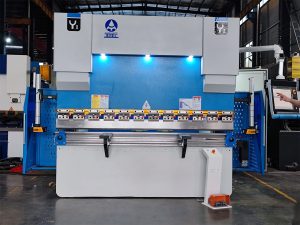Hydraulic press brakes, also known as hydraulic bending machines or simply as hydraulic brakes, are widely used in metalworking industries for sheet metal bending operations. These machines rely on the principles of hydraulics to apply precise and controlled pressure to metal sheets, allowing for accurate and repeatable bending. Here’s a step-by-step breakdown of how a hydraulic press brake operates during its work cycle:

Initialization and Setup:
Before the press brake cycle begins, the machine must be properly set up. This includes selecting the appropriate die set for the type of bending to be performed, adjusting the ram stroke length to the desired bend depth, and setting the pressure and speed parameters as required for the specific material being worked.
Start of the Cycle:
The operator initiates the press brake cycle, typically by pressing a foot pedal or button. This sends a signal to the hydraulic system to start the process.
Hydraulic System Activation:
Upon receiving the signal, the hydraulic pump, which is the heart of the hydraulic system, starts to operate. It draws in hydraulic oil from the reservoir and pressurizes it.
Ram Movement:
The pressurized oil is then directed to the hydraulic cylinder (or ram) through control valves. The oil pressure pushes the piston within the cylinder, causing the ram to move upward. This movement lifts the upper die (punch) into position to contact the metal sheet.
Sheet Insertion and Positioning:
While the ram is moving upward, the operator places the metal sheet into the lower die (die shoe) and positions it correctly for bending. The sheet is held in place by the clamps or fingers, which are part of the press brake’s bed.

Bending Operation:
Once the upper die makes contact with the metal sheet, the ram continues its upward movement, applying pressure to the sheet. The hydraulic pressure is controlled to ensure that the bending force is sufficient to deform the metal without exceeding the material’s yield strength, which could lead to cracking or other defects.
Holding Pressure:
After the metal sheet has been bent to the desired angle, the hydraulic system maintains pressure (holding pressure) for a brief period to ensure that the bend is formed accurately and consistently. This is particularly important for complex bends or when working with materials that are more prone to springback.
Ram Retraction:
Once the bend is complete, the control valves change the flow of hydraulic oil, which causes the ram to retract back to its starting position. This is achieved by the oil being directed back to the reservoir or to the opposite side of the piston, depending on the design of the hydraulic system.
Sheet Ejection and Cycle Repeat:
With the ram retracted, the operator or an automated system removes the bent sheet from the lower die. The press brake is then ready for the next sheet to be inserted, and the cycle begins anew.
Maintenance and Safety:
Throughout the operation, it’s crucial to monitor the hydraulic system for any signs of leaks, overheating, or other issues that could affect the performance and safety of the press brake. Regular maintenance, including checking and replacing hydraulic oil and inspecting the ram and valves, ensures the longevity and reliability of the machine.
In summary, hydraulic press brakes work by using a hydraulic system to control the movement of a ram, which applies pressure to a metal sheet held in place by the lower die. The precise control of hydraulic pressure allows for accurate and consistent bending of various metal sheets, making hydraulic press brakes an indispensable tool in metal fabrication.

